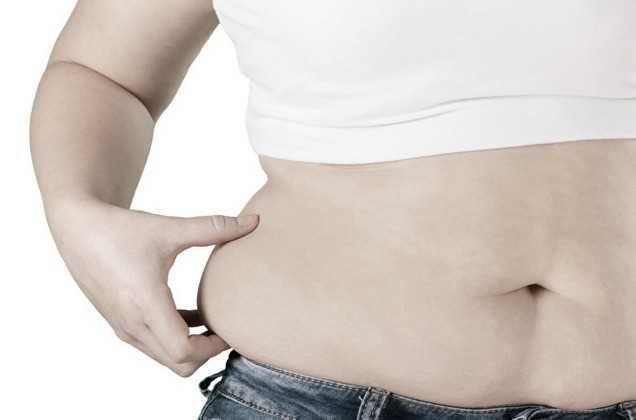Acc. to a 2008 study, men and women differ in the patterns of fat deposition, fat mobilisation, utilisation of fat as a metabolic fuel, and the consequences of both excess and insufficient fat stores. These differences begin early in life, and are further strengthened during puberty. These differences stem from metabolic and hormonal differences between the sexes, and contribute to differences between women and men in health risks attributable to obesity.

Acc. to a 2018 study, females have more fat stores than men. Also, fat deposits are distributed differentially in women and men, especially after the puberty because of the hormonal effect. Before puberty, females have higher amounts of subcutaneous fat that age-matched boys. Women maintain this pattern, with more fat stores in the gluteal-femoral regions which determine the typical Pear shape for women (Peripheral obesity or gynoid type).
Men tend to be more likely to have significant amounts of abdominal fat and to be more susceptible to abdominal adiposity (Central obesity or android type or apple shape). Also, men are more likely to have higher visceral fat, but some paradoxical observation could be present if the fat stores increase in large amount in which obese men have more significant amounts of subcutaneous fat on their legs.
(Subcutaneous fat consists of app. 90% fat which lies as a layer just beneath the skin. The remaining 10% — called visceral or intra-abdominal fat — which is found in the spaces surrounding the liver, intestines, and other organs. Though visceral fat make up a small part of the total fat, but is primarily responsible for the majority of health problems. On the other hand, subcutaneous fat is actually beneficial in number of ways.)
Acc. to a 2017 study, it has been proposed that circulating hormones in the body, determine these sex-specific differences in adipose tissue distribution, which can be observed even after menopause, but are much more pronounced during the reproductive phase. However, sex differences in fat distribution can be observed even before puberty, although they become much more pronounced after pubertal onset, suggesting that at least some mechanisms of differential adipose tissue distribution are unrelated to sex steroids.
Women have greater adipose stores than men, even after correcting for BMI. This is true for all races and all cultures. This sex difference in adiposity is present at birth. Female babies have more subcutaneous fat than do male babies for all gestational ages. Prepubertal girls have more fat in their legs and pelvis than do prepubertal boys.
Acc. to a 2012 study, for the same body mass index (BMI), women typically present with app. 10% higher body fat compared to men. Aging increases adiposity in both sexes, but again, women are characterized by higher percent body fat throughout the entire life span.
Women have larger stores of subcutaneous fat; men are more likely to have visceral fat. But, obese women will have large amounts of visceral fat; obese men will have large amounts of subcutaneous fat on their legs.
Acc. to a 2013 study, females experience a continuous increase in body fat throughout development and although males as well display a persistent increase in absolute body fat, they have the highest percentage of body fat during puberty.
As we saw that, females predominantly accumulate subcutaneous fat, males amass significantly more visceral fat, this sex difference in visceral adipose diminishes at older ages as postmenopausal women have increased visceral fat, emphasizing the role of gonadal steroids in this phenomenon.
WHY DO WOMEN STORE MORE FAT THAN MEN?
Women generally have a higher percentage of body fat than men. A healthy range of body fat for women is 20-25%, and a healthy range of body fat for men is 10-15%. A body fat percentage over 20% for men or 30% for women is considered an indication of obesity.
Body fat distribution varies among individuals and is a determinant of cardiovascular risk. Some people carry more of their body fat in and around the abdominal area. This type of fat deposition, called as the android, or apple type, is most characteristic among males, and is associated with a higher risk for cardiovascular disease.

Acc. to a 2009 report, estrogen reduces a woman’s ability to burn energy after eating, resulting in more fat being stored around the body. The likely reason is to prime women for childbearing, female puberty and early pregnancy – times of increased estrogen – could be seen as states of efficient fat storage in preparation for fertility, foetal development and lactation.
Study’s author Associate Professor Anthony O’Sullivan, said, “From an energy balance point of view there is no explanation why women should be fatter than men, particularly since men consume more calories proportionately. In fact, women burn off more fat than men during exercise, but they don’t lose body fat with exercise as much suggesting women are more efficient fat storers at other times.“
Many of these differences may reflect evolved adaptive differences that stem from the differences in male and female reproductive costs. Reproduction is more nutritionally expensive for women than it is for men. The costs of gestation and lactation dwarf male reproductive effort. This asymmetry in reproductive cost is reflected in the asymmetry in fat storage and in the utilisation of fat as fuel.
Associate Professor O’Sullivan stressed that while estrogen’s effects on postprandial fatty acid oxidation provide a mechanism for fat accumulation, the findings do not explain why some women are obese. Factors contributing to obesity are complex and include both genetic and environmental factors, he said.
Acc. to a 2011 study, in the first half of pregnancy, women increase their fat mass without evident increases in energy intake or decreases in expenditure. This ability to increase fat mass without substantial increases in energy intake points to the existence of metabolic adaptations that may contribute to the gender difference in fat mass.
Study also found that, differences in rates of glucose and fat oxidation during exercise do not seem to explain the gender difference in fat mass. Women preferentially burn a higher fat-to-glucose fuel mixture during exercise. Despite this, women lose less fat than men when faced with a similar energy deficit. This may be related to more efficient fat storage during non-exercising periods. The higher fat mass in women may allow them to preferentially use this energy source as a fuel while exercising, whereas during the non-exercising times, women are storing fat more efficiently compared with men.
The reason researchers found was that, women were found to revert to a state of reduced fatty acid oxidation immediately after exercise, which persists for hours. In addition, postprandial free fatty acid release from adipose tissue was reported to be lower in women than men. Acc. to studies, Men oxidise a greater percentages of ingested fat. Postprandial fatty acid uptake by upper body subcutaneous and lower body adipose tissues were higher in women than men. Since the amount of energy expended in post-absorptive and postprandial states is greater than during exercise, this will have a great bearing on overall fat storage and FM.

A 2001 study, found that, there are pronounced regional differences in the regulation of regional fatty acid metabolism between men and women. Leg free fatty acid release is lower in women than in men, whereas, free fatty acid release by the upper body subcutaneous fat depots is higher in men than in women. The overall fat oxidation is lower in females as compared to males, thereby contributing to a higher fat storage in women.
Finally, postprandial fat storage may be higher in subcutaneous adipose tissue in women than in men, whereas storage in visceral adipose tissue has been known to be higher in men. Furthermore, the proportion of energy derived from fat during exercise is higher in women than in men.
FAT MEN ARE MORE AT DISEASE RISK THAN FAT WOMEN
The fat in men is more problematic when it comes to disease risk. A 2004 study, suggested that, the tendency to accumulate body fat in intra-abdominal fat stores is linked to increased risk of CVD, metabolic syndrome, diabetes and other insulin-resistant states.

Acc. to a 2008 study, central or abdominal obesity, excess adipose tissue in the abdominal area, is associated with higher risks of co-morbid disease states, such as type 2 diabetes, hypertension, dyslipidaemia and CVD in both men and women. Lower body adiposity is associated with a less unhealthy metabolic profile. Overweight and obese women and obese men who had a higher proportion of fat in subcutaneous thigh adipose tissue were significantly less likely to display symptoms of the metabolic syndrome.
Obese individuals with mostly peripheral fat, distributed in subcutaneous depots in the gluteal-femoral region, are at lower risk of the common co-morbidities of obesity than are obese individuals with a large proportion of their fat in intra-abdominal depots.
Although the accumulation of subcutaneous fat in the lower body might represent a healthier regulation of fat stores compared with abdominal fat, excess adipose tissue is still associated with poor health outcomes.
Abdominal fat mainly consists of visceral and subcutaneous adipose tissue; the proportions of fat between these deposits differ between men and women, and also differ among racial and ethnic groups. The metabolic and health consequences appear to differ as well. Visceral fat is associated with a greater likelihood of adverse health conditions, although excess subcutaneous abdominal fat has been implicated in poor glucose regulation.
Men have consistently been shown to have greater rates of both fatty acid release (lipolysis) and fatty acid uptake (lipogenesis) in visceral fat compared with women. Women have higher rates of fat uptake into leg fat depots than do men. Rates of fatty acid release from abdominal adipose tissue are higher in women than men. However, in women the majority of fatty acid uptake in abdominal adipose tissue is into subcutaneous fat, while in men a larger proportion goes into visceral fat.
The gonadal hormones affect adipose tissue metabolism, and appear to play significant roles in the resulting distribution and consequences of stored fat. Testosterone acts to increase lipolysis and inhibit lipoprotein lipase activity. Lowering circulating testosterone levels in healthy young men increases total adipose tissue, with the largest percentage increase occurring in subcutaneous adipose tissue; raising circulating testosterone decreases total adipose tissue.
Estrogens play multiple roles in the regulation of adipose tissue, in both men and women. Estradiol has direct effects on adipose tissue, and also acts centrally to affect food intake and energy expenditure. Estradiol favours the deposition of subcutaneous fat; lack of oestrogen in women leads both to weight gain, and a larger proportion of fat gain in visceral fat. Menopausal women have higher visceral fat mass than do premenopausal women for the equivalent percentage body fat.
Acc. to a 2015 study, in men, abdominal fat tends to accumulate in the visceral area to a greater extent than in women and for a similar fat mass, men have on average a twofold higher visceral fat accumulation compared to women. It is generally accepted that sex-specific differences in body proportions and fat distribution differences in adiposity, fat free mass, and bone mass reflect, at least in part, differences in endocrine status, (estrogens, androgens, growth hormone—GH, and Insulin Growth Factor-1—IGF-1) that emerge starting from a prepuberal stage.
The magnitude of the difference between sexes are amplified with maturation, and particularly from late puberty to early adulthood when males gain a more android body shape and females a more gynoid shape clearly suggesting an involvement of sex hormones.
There is also a definite difference between sexes in age-related changes of whole-body fat distribution, especially in the abdominal fat tissues, and that the accumulation of visceral fat is markedly accelerated after menopause. In fact, after menopause, women tend to accumulate more fat in the visceral depot in a “men fashion” pattern.



